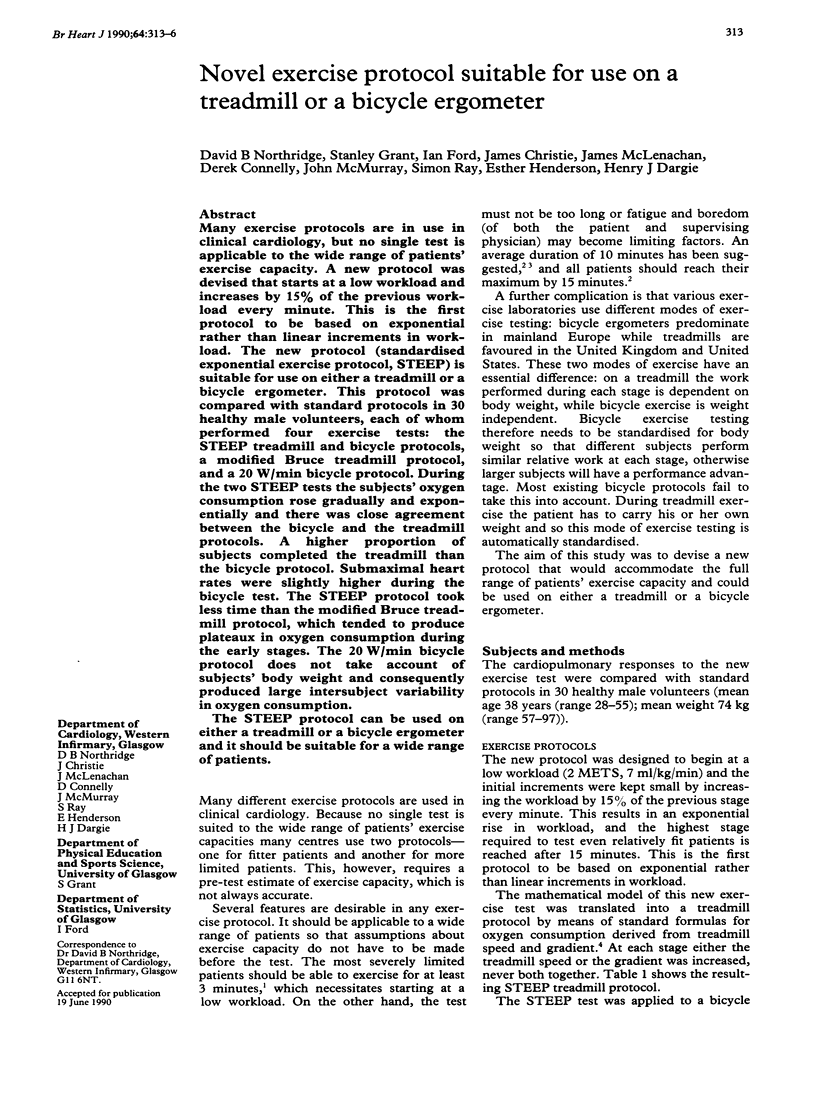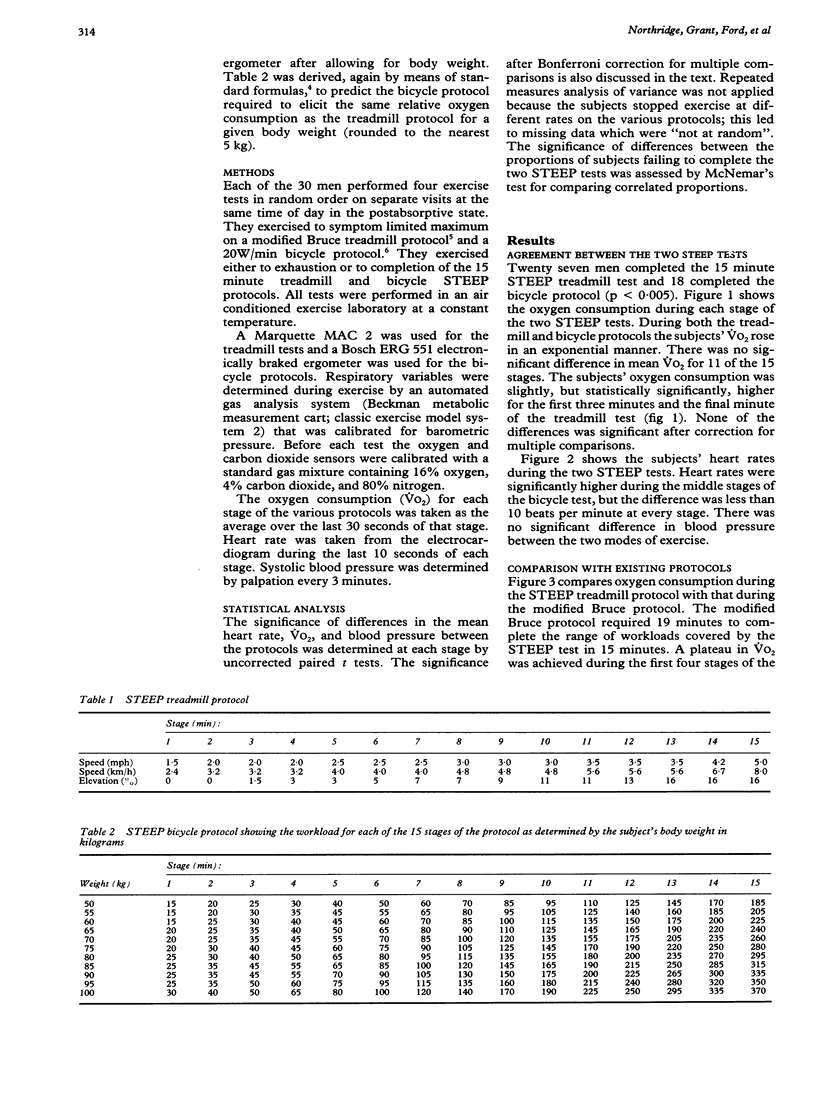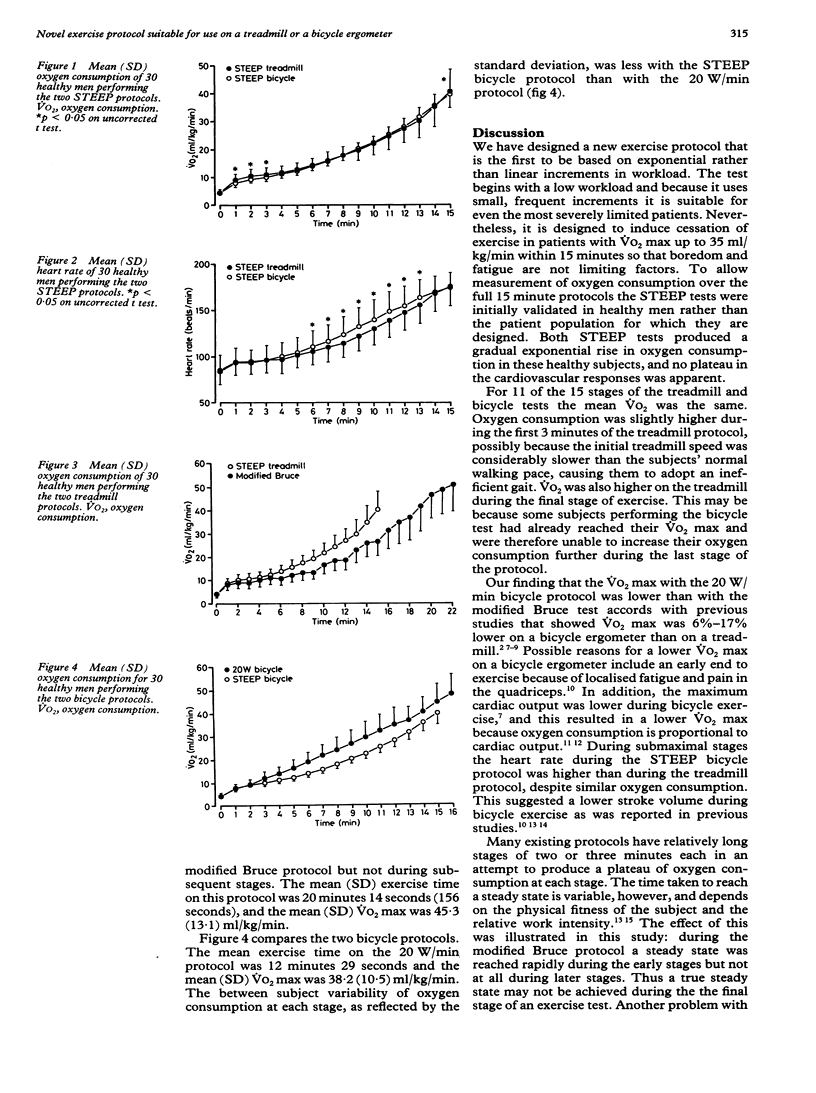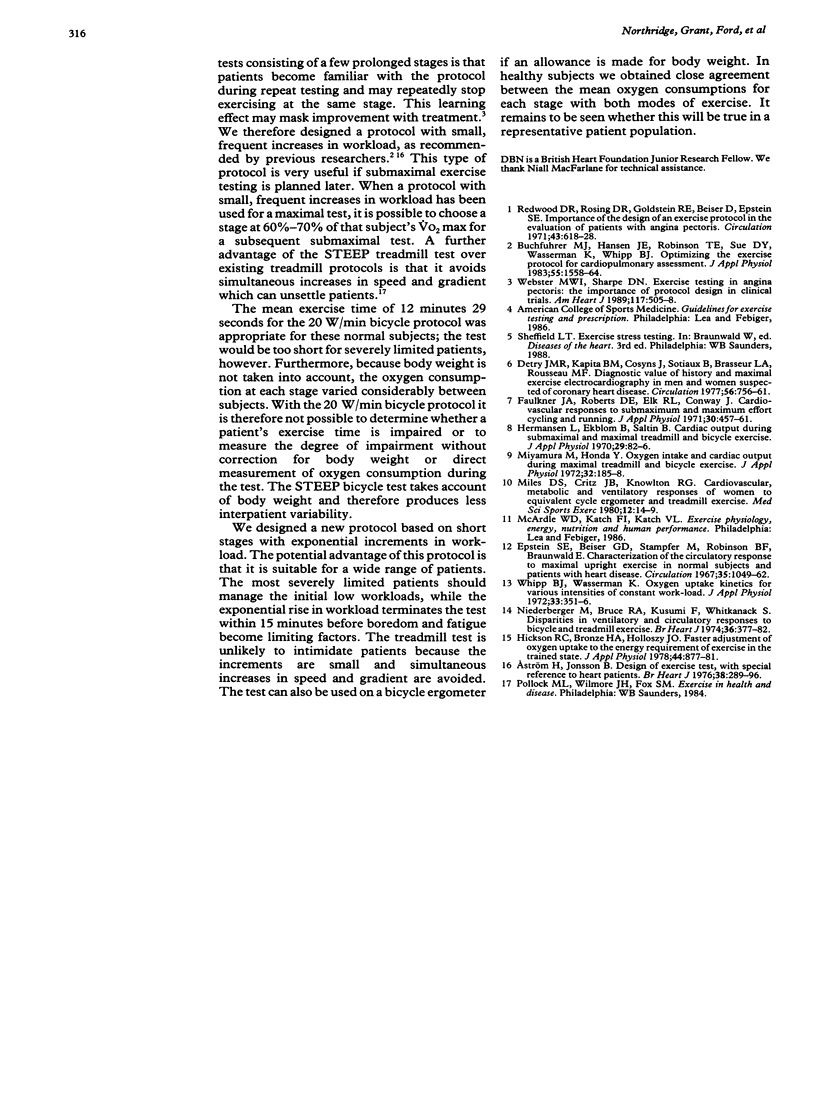Abstract
Many exercise protocols are in use in clinical cardiology, but no single test is applicable to the wide range of patients' exercise capacity. A new protocol was devised that starts at a low workload and increases by 15% of the previous workload every minute. This is the first protocol to be based on exponential rather than linear increments in workload. The new protocol (standardised exponential exercise protocol, STEEP) is suitable for use on either a treadmill or a bicycle ergometer. This protocol was compared with standard protocols in 30 healthy male volunteers, each of whom performed four exercise tests: the STEEP treadmill and bicycle protocols, a modified Bruce treadmill protocol, and a 20 W/min bicycle protocol. During the two STEEP tests the subjects' oxygen consumption rose gradually and exponentially and there was close agreement between the bicycle and the treadmill protocols. A higher proportion of subjects completed the treadmill than the bicycle protocol. Submaximal heart rates were slightly higher during the bicycle test. The STEEP protocol took less time than the modified Bruce treadmill protocol, which tended to produce plateaux in oxygen consumption during the early stages. The 20 W/min bicycle protocol does not take account of subjects' body weight and consequently produced large intersubject variability in oxygen consumption. The STEEP protocol can be used on either a treadmill or a bicycle ergometer and it should be suitable for a wide range of patients.
Full text
PDF



Selected References
These references are in PubMed. This may not be the complete list of references from this article.
- Aström H., Jonsson B. Design of exercise test, with special reference to heart patients. Br Heart J. 1976 Mar;38(3):289–296. doi: 10.1136/hrt.38.3.289. [DOI] [PMC free article] [PubMed] [Google Scholar]
- Buchfuhrer M. J., Hansen J. E., Robinson T. E., Sue D. Y., Wasserman K., Whipp B. J. Optimizing the exercise protocol for cardiopulmonary assessment. J Appl Physiol Respir Environ Exerc Physiol. 1983 Nov;55(5):1558–1564. doi: 10.1152/jappl.1983.55.5.1558. [DOI] [PubMed] [Google Scholar]
- Detry J. M., Kapita B. M., Cosyns J., Sottiaux B., Brasseur L. A., Rousseau M. F. Diagnostic value of history and maximal exercise electrocardiography in men and women suspected of coronary heart disease. Circulation. 1977 Nov;56(5):756–761. doi: 10.1161/01.cir.56.5.756. [DOI] [PubMed] [Google Scholar]
- Epstein S. E., Beiser G. D., Stampfer M., Robinson B. F., Braunwald E. Characterization of the circulatory response to maximal upright exercise in normal subjects and patients with heart disease. Circulation. 1967 Jun;35(6):1049–1062. doi: 10.1161/01.cir.35.6.1049. [DOI] [PubMed] [Google Scholar]
- Faulkner J. A., Roberts D. E., Elk R. L., Conway J. Cardiovascular responses to submaximum and maximum effort cycling and running. J Appl Physiol. 1971 Apr;30(4):457–461. doi: 10.1152/jappl.1971.30.4.457. [DOI] [PubMed] [Google Scholar]
- Hermansen L., Ekblom B., Saltin B. Cardiac output during submaximal and maximal treadmill and bicycle exercise. J Appl Physiol. 1970 Jul;29(1):82–86. doi: 10.1152/jappl.1970.29.1.82. [DOI] [PubMed] [Google Scholar]
- Hickson R. C., Bomze H. A., Hollozy J. O. Faster adjustment of O2 uptake to the energy requirement of exercise in the trained state. J Appl Physiol Respir Environ Exerc Physiol. 1978 Jun;44(6):877–881. doi: 10.1152/jappl.1978.44.6.877. [DOI] [PubMed] [Google Scholar]
- Miles D. S., Critz J. B., Knowlton R. G. Cardiovascular, metabolic, and ventilatory responses of women to equivalent cycle ergometer and treadmill exercise. Med Sci Sports Exerc. 1980 Spring;12(1):14–19. [PubMed] [Google Scholar]
- Miyamura M., Honda Y. Oxygen intake and cardiac output during maximal treadmill and bicycle exercise. J Appl Physiol. 1972 Feb;32(2):185–188. [PubMed] [Google Scholar]
- Niederberger M., Bruce R. A., Kusumi F., Whitkanack S. Disparities in ventilatory and circulatory responses to bicycle and treadmill exercise. Br Heart J. 1974 Apr;36(4):377–382. doi: 10.1136/hrt.36.4.377. [DOI] [PMC free article] [PubMed] [Google Scholar]
- Redwood D. R., Rosing D. R., Goldstein R. E., Beiser G. D., Epstein S. E. Importance of the design of an exercise protocol in the evaluation of patients with angina pectoris. Circulation. 1971 May;43(5):618–628. doi: 10.1161/01.cir.43.5.618. [DOI] [PubMed] [Google Scholar]
- Webster M. W., Sharpe D. N. Exercise testing in angina pectoris: the importance of protocol design in clinical trials. Am Heart J. 1989 Feb;117(2):505–508. doi: 10.1016/0002-8703(89)90806-5. [DOI] [PubMed] [Google Scholar]
- Whipp B. J., Wasserman K. Oxygen uptake kinetics for various intensities of constant-load work. J Appl Physiol. 1972 Sep;33(3):351–356. doi: 10.1152/jappl.1972.33.3.351. [DOI] [PubMed] [Google Scholar]


